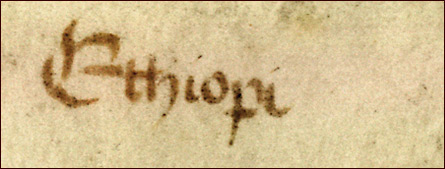
Black Ink
When researchers at the British Museum first subjected the faded black pigment
to scientific scrutiny in 1967, they were struck by how different it seemed
from most medieval inks. Medieval iron-gall inks, including those used on the
Tartar Relation and Speculum Historiale, usually appear dark
under ultraviolet light, but this pigment fluoresces. In the 1990s scientists
Robin Clark and Katherine Brown, using a newly developed technique known as
Raman probe spectroscopy, confirmed that the pigment is carbon-based and unlike
the iron-based inks historians would expect to see on a genuine medieval
map.
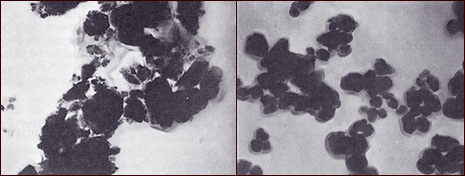
Yellow-Brown Lines
A debate has raged for decades over whether or not the yellow-brown lines of
the map hold the telltale sign of forgery. In the 1970s, researchers at Walter
McCrone and Associates, a firm specializing in chemical analysis, examined
ultramicroscopic samples from the yellowish lines. They identified crystals of
the mineral anatase in a particular rounded form that was manufactured only
after around 1920. In the 1980s, a group of researchers lead by physicist
Thomas Cahill of the University of California, Davis challenged the McCrone findings, suggesting that
the McCrone team mistakenly sampled paint that had fallen onto the inked lines
of the map from a modern ceiling. More recent work using Raman probe
spectroscopy has corroborated the McCrone discovery of the suspicious mineral
crystals.

Off-Register Lines
The lines of the map appear aged and worn, yellow-brown in color with flakes of
black pigment on top. Was the map drawn with a single application of black ink,
most of which flaked off, leaving behind a yellow-brown stain or binding agent?
Or, as chemical analyst Walter McCrone asserts, did a forger mimic this effect?
At one spot on the west coast of Great Britain, the yellow-brown and black
lines appear out of register. Smithsonian scientist Kenneth Towe points to this
as evidence that the yellow-brown line was drawn separately. Researchers at the
University of California, Davis who defend the map's authenticity counter that this is the only
place on the map where the lines don't match up and that it could be the mark
of a medieval scribe retracing a sketchy line with fresh ink. Even some
skeptics of the map reject the idea of a "double-inking."
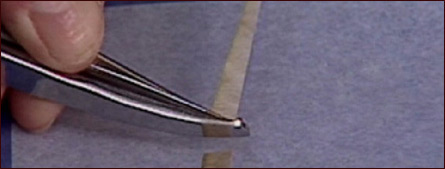
Parchment Date
The map is drawn on parchment, animal hide that can be radiocarbon dated.
University of Arizona researchers, who had to destroy a sliver of parchment for
the test, selected a fragment at the bottom edge unmarked by text or drawing.
Their results dated the parchment to within 11 years of 1434, the time frame
noted by the map's defenders. But the test merely proved that the parchment was
medieval, not the ink of the map itself. A forger would likely have used an old
parchment to give his or her work an authentic air and could have even used parchment
from the Speculum Historiale itself, which appears to have at least one
section missing.
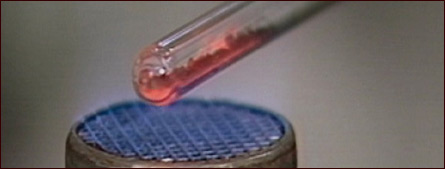
Atomic-Era Substance
The researchers who dated the parchment first had to clean off a carbon-based
coating either on the map's surface or embedded in its fabric. The exact nature
of this coating remains controversial, but it clearly contains carbon dating to
the mid-20th century. It appears to have been deliberately applied
to the parchment around the time of the map's emergence in the 1950s. The
atomic-era substance may simply reflect an undocumented attempt in the 1950s to
conserve an authentic medieval map, but it may also be a sign of forgery. If a
forger used a 15th-century parchment, he or she likely would have
scrubbed it clean of markings and then prepared a smooth surface on which to
draw, perhaps with this substance.
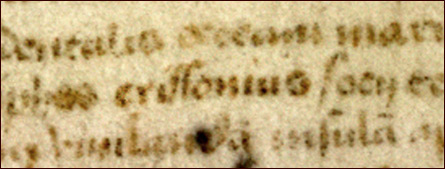
Vinland Text
The longest caption, and certainly the most discussed part of the map, claims
that Viking adventurers reached American shores hundreds of years before
Columbus. It was hardly the first such claim—two Icelandic sagas include
tales of Vinland, and a forger could have garnered details from these sagas and
other historical sources. The map's Latin text notes that Leif Eriksson was
together with a companion named Bjarni when he discovered Vinland, a curious
detail that Norse scholar Kirsten Seaver says runs counter to the information
in the sagas and originated with a history of Greenland written in 1765.
Skeptics of the map also point to the Latin translation of Eriksson
("erissonius") as a red flag. A medieval scribe would likely have used the
separate word "filius" for "-sson." The use of "-sonius" became common only
after 1600.
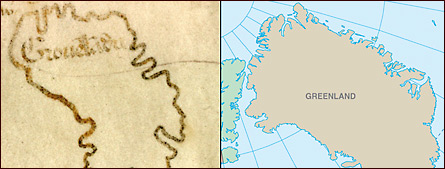
Island of Greenland
The appearance of Greenland as an island troubled even the experts who helped
"authenticate" the map for Yale in the 1960s. The Norse undoubtedly colonized
Greenland by A.D. 1000, but medieval Scandinavian accounts suggest that
Greenland was not perceived to be an island. An undisputed map from 1427
depicts Greenland as the end of a peninsula stretching toward the arctic north.
Arctic ice conditions made sailing along Greenland's northern coast
treacherous, if not impossible, and the first piecemeal circumnavigation of
Greenland was completed around the turn of the 20th century. What's more, the
outline of Greenland—with its detailed coastline—is suspiciously
similar to Greenland's depiction on modern maps.
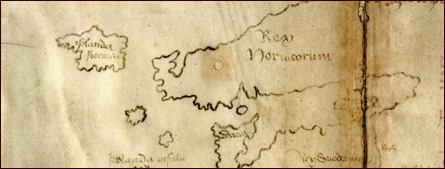
Scandinavia
It is odd that a map providing intricate details of Viking exploration depicts
the Viking homeland of Scandinavia in such a sketchy and inaccurate way. The
map shows Norway—Rex Noruicorum—as an immense peninsula
stretching over the Baltic Sea and wrongly locates Sweden—Rex
Suedorum—south of the Baltic. Defenders of the Vinland Map never
claimed that the map's author was Scandinavian, but they have suggested that
the medieval scribe used Scandinavian as well as Venetian maps as
references.
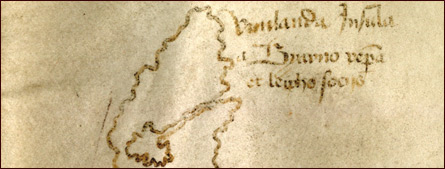
Vinland
This large island with two deep bays gave the map its name and propelled it to
fame and notoriety. To the right of the island, a Latin label reads, in
translation, "Island of Vinland discovered by Bjarni and Leif in company." The
Norse sagas tell of Vinland as a fertile place of wild grapes, but they offer
only a vague geographic description, lacking the quite specific details shown
on the map. It is also puzzling why a medieval scribe would have singled out
Vinland and not have included other locations in North America that the Norse
explored and later described in the sagas, such as Helluland and Markland.
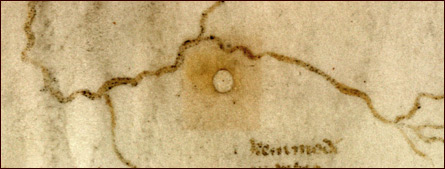
Wormholes
Rare book collector Laurence Witten, who bought the map from an Italian dealer
in 1957, was thrilled to find that holes in it lined up with holes in the front
pages of the Speculum Historiale. In turn, a hole in the later
pages of the Speculum had a match in the front pages of the Tartar
Relation. This evidence, linking the map with two medieval documents,
helped seal Witten's sale of it to Yale for an undisclosed but exorbitant
price. The map's nine holes don't appear to have been made with a drill, and
some go directly through lines of ink. But skeptics point out that they are
located more in the center than at the edges of the map, where worms would
likely nibble. A forger could have bound the map together with the authentic
documents and then set some hungry worms to work. No one knows the age of the
holes.
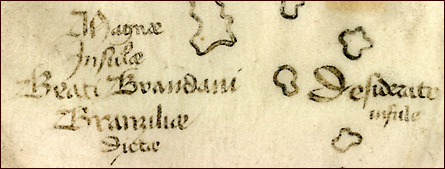
Handwriting
The Yale team that declared the map authentic in the 1960s believed it was
written in the same hand as the Tartar Relation and Speculum
Historiale, but others don't agree. When the map was shown to the Keeper of
Manuscripts at the British Museum in 1957, he rejected it in part because he
thought the handwriting had a 19th-century look. Several paleographers (experts
in ancient writing), including the woman who catalogued the map and the other
two texts for Yale in the 1980s, point to differences in the handwriting of the
map and its supposed companions. Kirsten Seaver goes further—spotting
similarities, including a horizontally looped "d" and a wavering tendency, in
both the map's writing and the hand of Father Josef Fischer (1858-1944), a
Jesuit expert on medieval geography whom Seaver considers the map's true
author.

Page Fold
Whoever drew the Vinland Map appears to have done as much as possible to avoid
drawing across the page fold. Geographic names are positioned to either side of the
fold, rather than crossing it. The Adriatic Sea is even widened so that Greece
and Italy lie safely to the sides of the fold, and some European rivers appear
re-routed to avoid it. Knowing that the map would be folded, would a medieval
scribe have avoided marking this area? Or is this fold-avoidance a clue that a
modern map was made on an old piece of parchment, long after the fold crease
developed?
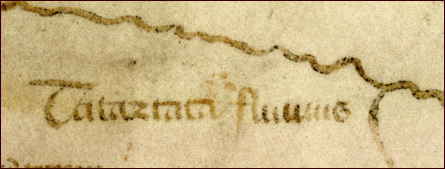
River Tatartata
This name, like many of the geographic labels on the map, appears to have been
copied from the first few pages of the Tartar Relation. On the first
page of this authentic text, two words, "tatar" and "tata," are next to one
another. Punctuation that should separate the two words is missing. The Vinland
Map author mistakenly joins them as one word on the map. Was this copying
mistake made by a medieval scribe or a 20th-century forger trying to
draw links between an authentic text and a forged map?


| 
|














